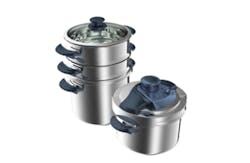Contaminant of the Month: Chromium VI
What is it:
- Chromium VIor CrVI or Cr+6 is the highest oxidation state of the chromium element.
- The most common forms of chromium are CrVI and CrIII as well as the metal.
- Chromium (At.No. 24, At.Wt. 51.99) is the 21st most abundant element in the earth’s crust.
- It is found in plants, rocks, foods and in animals in small amounts.
- CrVI is an occupational carcinogen by inhalation; CrIII is a likely essential nutrient.
- CrVI became famous in the Erin Brockovitch movie about chromium groundwater contamination in Hinckley, Calif.
What are uses of CrVI:
- Chromium is a major component of chromium stainless steel. CrVI on the surface prevents rust formation.
- Chromium is present in the environment from the geology and also from industrial discharges.
- Chromium forms chromate (CrO4-2) and dichromate (Cr2O7-2) anions that are good oxidizing agents, especially in acidic solution.
- The chromate and dichromate salts are used as pigments and colorants in glazes, paints and in pyrotechnic displays, giving characteristic yellow colors.
Occurrence in water:
- A WaterRF funded study of 407 source waters found total chromium detections from < 0.2 ppb to 47.1 ppb. Average and median values were 1.1 ppb.
- California reported that five percent of its drinking water sources had CrVI at > 10 ppb.
- CrIII is quite insoluble in water, but if present it can be oxidized to CrVI by chlorination.
Health considerations:
- CrVI is rapidly reduced to CrIII after ingestion.
- CrVI is considered an occupational lung carcinogen by inhalation.
- A meta analysis of >30 occupational studies among highly exposed workers who swallowed chromium salts did not detect increases of GI or other cancers.
- The Hinckley population has not shown increases in possible chromium related cancers.
- Concern about systemic cancers was initiated by an NTP high dose ingestion study in rats and mice. There were oral and intestinal cancers at the high doses, but not lower doses.
- NTP speculated that the differences might be due to exceeding of the animals’ natural capacity to reduce CrVI to III.
- Both California and U.S. EPA carried out hypothetical quantitative risk assessments that arrived at cancer risks at sub ppb doses, however, both assessments ignored the natural chemical reduction processes that spontaneously occur at orders of magnitude above the drinking water concentrations.
- The American Chemistry Council funded independent mechanistic studies and concluded that CrVI is not carcinogenic at drinking water exposure levels.
Analytical methods:
- Total chromium is measurable by ICPMS (EPA 200.8) as well as by Graphite Furnace Atomic Absorption (EPA 200.9). Detection levels are sub ppb.
- CrVI can be analyzed by ion chromatography EPA 218.6. Detection level 0.02 ppb.
Water treatment:
- Total Cr and CrIII are removable by conventional treatment and lime softening.
- CrVI must first be reduced to CrIII, such as by sulfite, sulfide or ferrous salts.
- Anion exchange is effective since the chromium is in an oxychromium anionic form.
Regulation:
- The original 1946 U.S. Public Health Service chromium standard was 50 ppb. It conservatively assumed that all of the chromium might be in the VI state.
- Subsequent Interim Primary Drinking Water MCL was also 50 ppb, and later raised to 100 ppb in the revised regulations, also assuming CrVI.
- California has a public health goal of 0.02 ppb and proposed an MCL of 10 ppb in 2013.
Dr. Cotruvo is president of Joseph Cotruvo and Associates, LLC, Water, Environment and Public Health Consultants. He is a former director of the U.S. EPA Drinking Water Standards Division.
